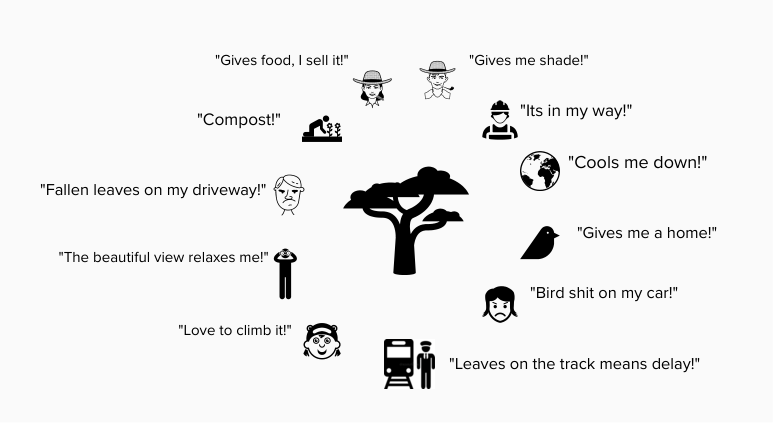So many people, so many perspectives….
When dealing with complex social problems, we are often unaware of the enormous number of different ways of looking at the problem. Often we have a vague idea, such as “Pete probably just wants to make more money,” but that is often all. And then we are surprised that we can’t solve the problem! Or worse, that we want to act quickly out of good will and then get all sorts of people on our roof who had a different perspective…
Take a tree, for example. By itself, of course, a tree is not a complex problem. But it can be part of a complex problem where people can’t figure it out and seem to be diametrically opposed: “the tree has to go” or “the tree has to stay!” – and then we often have the “voiceless” we often forget about, such as nature, animals and future generations… This picture is a (surely incomplete) representation of the perspectives that can exist on “a tree” alone! Perhaps you, dear reader, know of others?

Tackling fast ends up being very slow….
If we want to solve complex issues, it pays to explore those perspectives first. Pretty logical, right? And yet it happens so little! Because it has to be addressed quickly (also quite logical in itself). But then we fail to solve the most pressing problems for decades. In ‘the best’ case, those involved are brought together as quickly as possible to find solutions together.
But those same people involved, thinking that others probably want something different than they do, come to that meeting ‘armed’ with arguments, attack and defense tactics, so that ‘their’ idea will win. Not so good for the atmosphere it seems to me, let alone for a constructive brainstorm and innovative solutions….
The facilitator often stands there helplessly, trying to calm things down, but it is a losing battle, because there is no chance of getting them to brainstorm. Everyone is frustrated and the solution, instead of getting closer, seems further and further away….
How it can be done differently
But fortunately, it doesn’t have to be that way at all. As a Participatory Action Researcher (PAR practitioner) you work from the principle that everyone should first be able to share their perspective at ease, without having to defend, explain or justify themselves, and be heard in it. Therefore, in the first phases of the PAR, PAR practitioners often only have individual conversations and interviews with those involved, in which they ask them about their perspective on the current and desired situation, their needs, assets (things that are going well, abundance), solution directions and values. The PAR practitioner analyzes these and makes one or more clear visualization(s) of them. Only then does the PAR practitioner bring those involved together in a series of sessions, carefully weighing who would be best to meet when, in order to ultimately arrive together at a solution that works for everyone.
And then what happens…
At the moment when those involved first sit together in a session, the PAR practitioner does a number of important things that start an effective dynamic between them. He (or she, but let me stick with he) shows the visualization in which all perspectives are reflected, and thus in which the “shared reality” comes out well.
This is still only a rough representation of the results from the conversations; the PAO does not draw any conclusions from it and especially does not give any recommendations or advice. Instead, he asks those involved for their reaction to the visualization, and whether they want to add to it, so that they can then draw their own conclusions and arrive at solutions.
Perhaps somewhat irreverently put, but I always find this a fantastic ‘distraction tactic’. Where otherwise those involved are mainly focused on each other, fighting each other with the best arguments to let their idea ‘win’, now they look together at a visualization (read: their shared reality) and reflect on it. In addition, some interesting things happen. First, stakeholders recognize their own perspective in the visualization and thus feel heard and acknowledged in their perspective. Second, they gain greater understanding of others’ perspectives. Third, they see how the problem outlined is embedded in a broader system of causes and consequences, as well as assets, solution directions and values, and thus expand their knowledge. With these new insights, new possibilities and ideas emerge to address the issue.
From arguing to brainstorming and creating action plans
By comparing and matching the results in certain ways, they can connect the ideas and co-create a joint action plan from that.
Experiencing those “aha moments” together works great for starting a dynamic where all involved feel ownership – after all, their idea is also part of the action plan – and also feel like implementing that action plan together, because they discover how they can strengthen each other.
And even then it’s not easy – change is scary – but as a PAR practitioner you know better than anyone how to guide people through this, so that they can make the desired changes that make them happy.
Well, this -and much more- is the work of a PAR practitioner. Now that you’ve read this blog I’m sure you can think of situations – whether or not you watch the news – in which PAR can be used. Perhaps in your own work?
If you are interested in also learning how to apply PAR to address complex problems with many stakeholders, join the PAR Practitioners Program!
Will we see you soon at the SevenSenses Action Research Academy?
Greetings, also on behalf of the trainers,
Madelon – Founder SevenSenses
